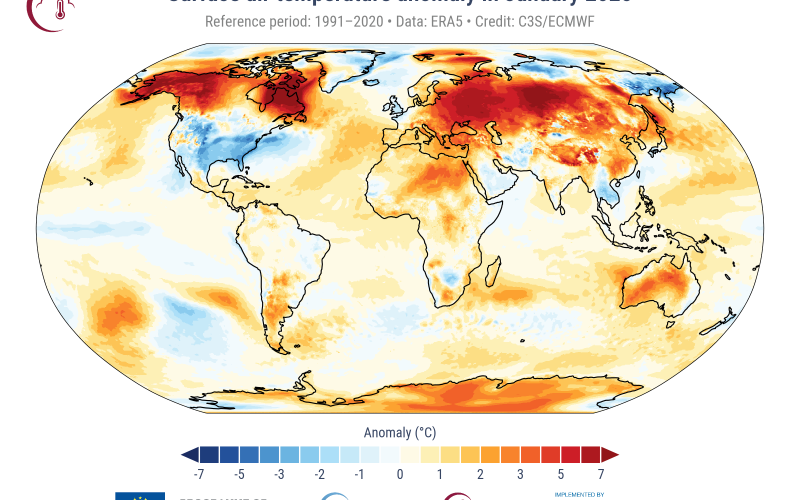January 2025 was the warmest ever recorded, with a global average surface air temperature of 13.23°C, according to Copernicus, part of the European Union’s space programme. The temperature was 0.79°C above the 1991-2020 January average and 1.75°C higher than pre-industrial levels.
This marks the 18th month in the past 19 months where the global average temperature has exceeded 1.5°C above pre-industrial levels. The 12-month period from February 2024 to January 2025 recorded a temperature 0.73°C above the 1991-2020 average and 1.61°C above pre-industrial levels.
Europe experienced its second-warmest January on record, with an average land temperature of 1.80°C, which was 2.51°C above the 1991-2020 average. The warmest January remains January 2020, when temperatures were 2.64°C above average.
Southern and eastern Europe, including western Russia, recorded the most significant temperature anomalies, while below-average temperatures were observed in Iceland, the UK, Ireland, northern France, and parts of Scandinavia.
Beyond Europe, above-average temperatures were recorded in Northeast and northwest Canada, Alaska and Siberia, Southern South America, Africa, Australia, and parts of Antarctica.
In contrast, below-average temperatures were observed in the United States, Easternmost Russia (Chukotka and Kamchatka), the Arabian Peninsula and mainland Southeast Asia.
The global sea surface temperature (SST) over 60°S–60°N for January 2025 was 20.78°C, making it the second-highest on record for the month. It was 0.19°C below the record set in January 2024.
While SSTs were below average in the central equatorial Pacific, they remained above average in the eastern equatorial Pacific, suggesting a slowing or stalling of the transition towards La Niña conditions. SSTs also remained exceptionally high in other ocean basins.
January 2025 saw wetter-than-average conditions across parts of Western Europe, Italy, Scandinavia, and the Baltic states, leading to flooding in some areas. The conditions were also observed in Alaska, Canada, central and eastern Russia, eastern Australia, and southeastern Africa.
Conversely, drier-than-average conditions were recorded in the Northern UK, Ireland, eastern Spain, and areas north of the Black Sea, the southwestern United States, northern Mexico, northern Africa, the Middle East, Central Asia, eastern China, southern Africa, southern South America, and Australia.
Arctic sea ice extent for January 2025 reached its lowest level for the month, measuring 6% below average, nearly tying with January 2018. Ice concentration was particularly low in Hudson Bay, the Labrador Sea, and the northern Barents Sea.
Antarctic sea ice extent was 5% below average, relatively close to the historical average compared to the record-low values seen in 2023-2024. The Amundsen Sea recorded above-average ice concentrations, while other Antarctic sectors showed mixed conditions.
Samantha Burgess, Strategic Lead for Climate at the European Centre for Medium-Range Weather Forecasts (ECMWF), described January 2025 as “another surprising month,” continuing the record-breaking temperature trends of recent years. Despite the development of La Niña, which typically has a cooling effect on global temperatures, warming has persisted at an alarming rate.
“Copernicus will continue to closely monitor ocean temperatures and their influence on our evolving climate throughout 2025,” she said.





















